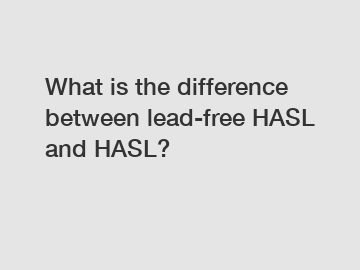What is the difference between lead-free HASL and HASL?
CHANYEE Product Page
What is the difference between lead-free HASL and HASL?
Lead-free HASL (Hot Air Solder Leveling) and HASL (Hot Air Solder Leveling) are two widely used techniques in the assembly and manufacturing of printed circuit boards (PCBs). Although they share a similar acronym, these processes have distinct differences that affect the final product's quality and environmental impact. Understanding these variances can help electronic manufacturers make informed decisions when selecting the appropriate soldering method for their PCBs.

1. Lead-Free HASL: .
Lead-free HASL, as the name suggests, is a soldering technique that eliminates the use of lead in the manufacturing process. This method has gained popularity due to increasing environmental regulations and concerns regarding the health risks associated with lead-based products. Lead-free HASL uses a tin-silver-copper (SnAgCu) alloy as a replacement for the traditional lead-tin (PbSn) coating. This alloy has a higher melting point than traditional lead-tin, which increases the durability and reliability of the solder joint.
2. HASL:
HASL, on the other hand, refers to the conventional Hot Air Solder Leveling process, which has been the industry standard for many years. In this technique, a thin layer of solder paste comprising lead and tin is applied to the copper traces on the PCB. The excess solder is then removed by passing the board over a hot-air knife or wave. The remaining solder solidifies to form a flat and even surface, enabling the attachment of electronic components.
Now let's explore the differences between these two techniques in more detail:
a. Environmental Impact:
One of the primary reasons for the widespread adoption of lead-free HASL is its reduced environmental impact. Traditional HASL involves the use of lead, which poses risks to both human health and the ecosystem. By eliminating lead, lead-free HASL complies with regulations such as the Restriction of Hazardous Substances (RoHS). This makes it an eco-friendly option, ensuring consumer safety and reducing the toxic waste generated during PCB manufacturing.
b. RoHS Compliance:
RoHS compliance is a crucial consideration in manufacturing electronic products. The goal of RoHS is to restrict the use of hazardous substances, including lead. As lead-free HASL meets the RoHS directive, it becomes a preferred choice for manufacturers who export their products to regions where RoHS compliance is mandatory.
c. Solder Joint Reliability:
Lead-free HASL offers improved solder joint reliability due to its higher melting point. The SnAgCu alloy used in lead-free HASL has a melting point above 220 degrees Celsius, which is much higher than the melting point of traditional lead-tin solder. This higher melting point reduces the risk of solder joint failure caused by thermal stress during operation. Therefore, lead-free HASL is particularly suitable for applications exposed to high temperatures or thermal cycling.
d. Cost Considerations:
Cost is an essential factor in the selection of soldering techniques. Traditionally, HASL has been an economically viable option due to the availability and low cost of lead-tin solder. In comparison, lead-free HASL may be more expensive due to the costlier tin-silver-copper alloy. The increased cost of materials and additional processing steps required for lead-free HASL might influence the decision-making process for manufacturers operating on tight budgets.
In conclusion, the ongoing shift towards environmental consciousness and regulatory compliance has led to the rise of lead-free HASL as an alternative to traditional HASL. While both techniques serve the purpose of soldering electronic components onto PCBs, lead-free HASL offers distinct advantages such as environmental friendliness, RoHS compliance, improved solder joint reliability, and higher melting point. However, it is essential for manufacturers to carefully evaluate their specific requirements, cost considerations, and environmental commitments before selecting the most suitable technique for their PCB assembly processes.
Are you interested in learning more about automotive pcb design ? Contact us today to secure an expert consultation!



